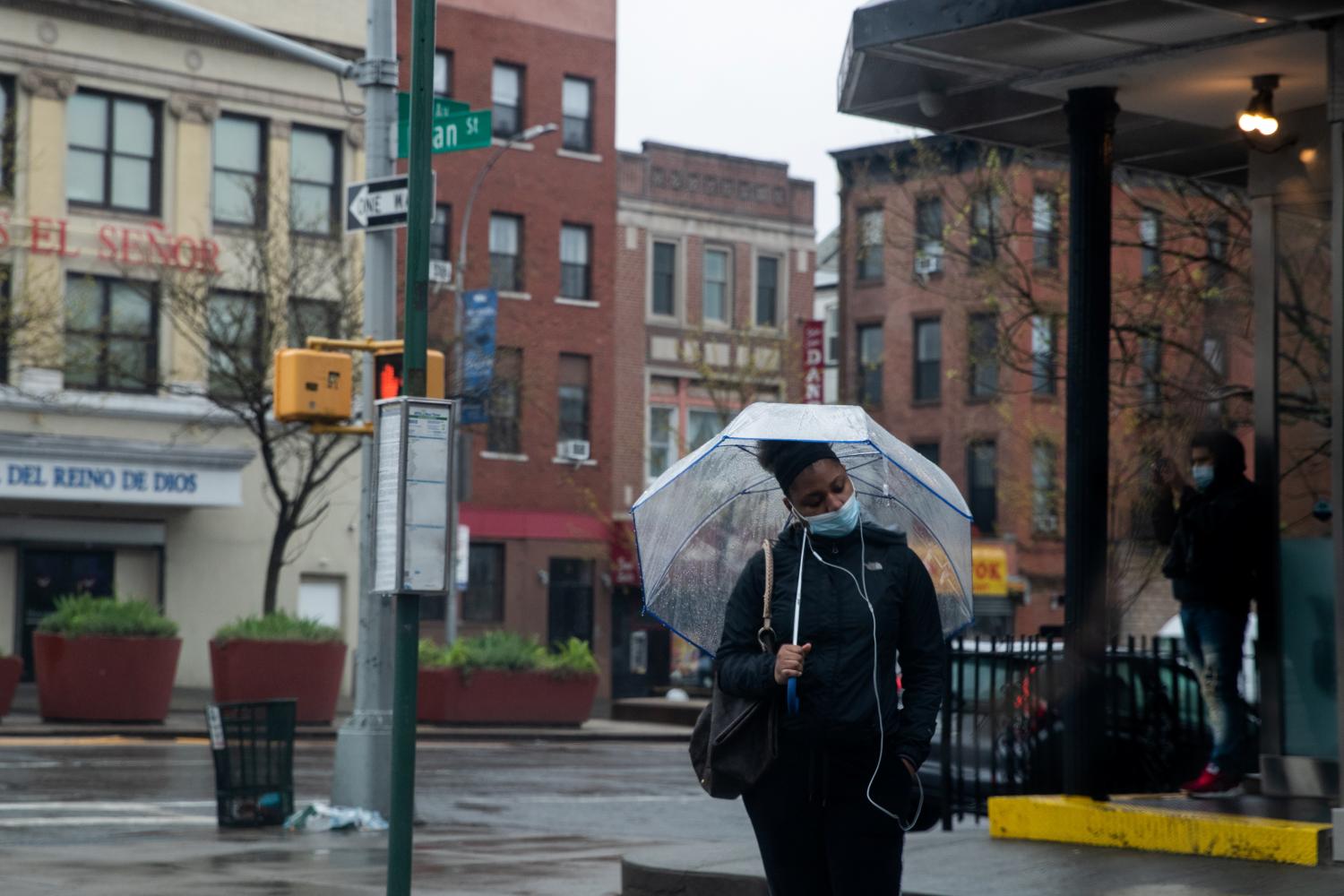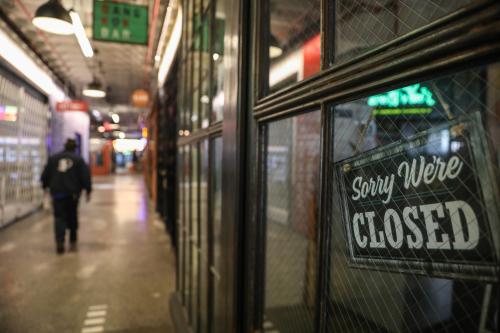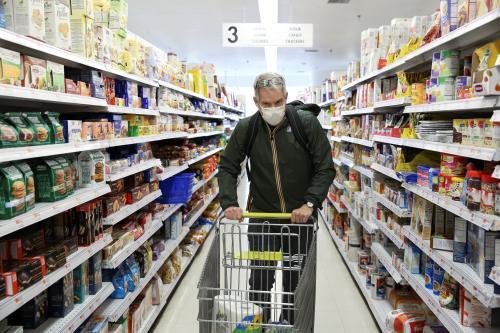World leaders are deliberating when and how to re-open business operations amidst considerable uncertainty as to the economic consequences of the coronavirus. One pressing question is whether or not countries that have remained relatively open have managed to escape at least some of the economic harm, and whether that harm is related to the spread of the disease. A related issue is what forms of relief are most effective at preserving the employer-employee relationship and securing the foundations for a robust recovery once the economy re-opens. Some countries have leaned heavily on their unemployment insurance system, whereas others have prioritized business relief, which mandates the preservation of employee relationships.
To shed some light on these issues, we compiled data on unemployment and related benefit claims from 20 wealthy countries. Given the unusual circumstances of the pandemic and the variation across countries in novel policy responses—including the introduction of business relief programs designed to prevent unemployment, these measures should not be regarded as fully capturing the scale of economic disruption in a comparable way. Nonetheless, these data offer a useful preliminary look at what is happening across countries as we wait for more complete data from statistical offices.
COVID decimating the labor force around the world
Since March, approximately 11.9% of workers across the 20 nations have registered as unemployed or otherwise benefitted from formal assistance provided through government support of employers. This represents 58 million workers.
Yet, because different countries have relied on different policy responses, there is tremendous variation across countries in whether affected workers have filed for unemployment insurance or accessed benefits through a short-term program that funds businesses to retain their workers. Overall, we find that 6.8% of workers (33 million) in this group of 20 countries have filed unemployment insurance claims through the traditional or expanded unemployment benefits systems, whereas 5.1% of workers (25 million) have received benefits from employer-supported programs that are designed to defray most of the costs of furloughing workers and keep them connected to their employer.
The United States stands out with 14.8% of its workforce having filed for unemployment benefits (Figure 1), which is the highest among the 20 countries surveyed. On the other end, Germany actually saw a decline in the share of its workers filing for unemployment insurance in March, 2020, even as an estimated 20% of its workers availed themselves of short-term benefits channeled from the government to employers (Figure 2).
As for the larger issue of how social distancing policies relate to economic disruption, these data show that there is no clear relationship between social distancing and the degree of economic harm. There is a modest negative relationship between testing and mortality, but at this stage in the epidemic, countries that have suppressed mortality are no better off economically (Table 1 below summarizes these data).
These patterns are particularly evident within Scandinavia. Scandinavian countries that have remained open—like Sweden and Iceland—have experienced similar levels of economic disruption as those with tighter restrictions—like Denmark and Norway. Of these four countries, Sweden has by far the highest number of deaths per capita, whereas Iceland has used extraordinary testing and quarantine measures to keep deaths down despite keeping businesses and schools open.
These preliminary results do not suggest any strong tradeoff between disease suppression and economic performance, but they do provide some evidence—illustrated by Iceland and Australia—that widespread testing and quarantine could substitute for severe restrictions on business and social life, as the pandemic unfolds.


How to get timely, comparable international data
The ideal way to measure economic disruption would be to launch a uniform large-scale survey using the same methods around the world. Rich countries do these surveys routinely, using harmonized methods to measure concepts like unemployment, but these data won’t be available in most countries for weeks. For example, the results of the next large-scale U.S. survey on the labor market (covering early April) won’t be reported until May 8th. Many countries are weighing decisions about whether and when to re-open even now.
An alternative strategy is to use government administrative data on claims or registrations for unemployment insurance. While eligibility rules vary across country, it is safe to assume that most people filing these claims have either lost their job or faced reduced hours or pay. When presented with data from February and March (or the post-pandemic period), we take the difference to try to isolate claims affected by COVID-19.
One complicating factor is that eligibility criteria for unemployment insurance claims have changed considerably in many countries in response to the pandemic. We are willing to assume that most benefits claimants have been genuinely affected by the crisis, so in our view, this relaxation in eligibility provides a more accurate depiction of economic disruption than would otherwise be the case. Thus, our data measure the change in benefits from early March until the most recent data (usually early April) and divide by the February labor force numbers. This can be thought of as a COVID job displacement rate.
Recent survey estimates from Gallup suggest at least twice as many workers have been laid off or seen reduced hours from COVID-19 as have filed unemployment insurance claims.
This displacement rate should be regarded as a low-end estimate of the true disruption facing workers for several reasons. Not everyone who is laid off or sees a reduction in hours applies for benefits, particularly if they believe their situation is short-term. In recent years, roughly 40% of unemployed workers actually received a benefit in the United States, though the figure is closer to 70% for those who meet eligibility standards, according to analysis from Ryan Nunn and David Ratner.
We have reason to believe that unemployment claims have understated harm to workers in the United States. Recent survey estimates from Gallup suggest at least twice as many workers have been laid off or seen reduced hours from COVID-19 as have filed unemployment insurance claims. Using updated data from the Gallup COVID-19 tracking survey from April 13-19th, we estimate that 18% of the U.S. labor force has been laid off (mostly temporarily) and 33% of the labor force has been either laid off or seen reduced hours.
Likewise, a number of country-specific issues complicate the relationship between unemployment insurance claims and economic disruption. Eligibility rules, familiarity with the benefits system, and employer or union relationships are all factors that vary both within countries and across them that could affect the relationship between true displacement and formal registration.
Moreover, as we discuss, some countries have created alternative business relief programs designed to make it unnecessary for workers to file for unemployment insurance. Whenever possible, we attempt to locate estimates for workers affected by these programs and include this in the analysis.
For countries with well-established short-term worker programs (like Switzerland), these data were readily available. For some countries with novel programs—like the United States—no estimates of use have been made available by the government, whereas other countries—like New Zealand—produce transparent weekly reports on the number of workers benefitting from its novel programs.
Worst of both worlds: Nations hit hardest economically and by the disease
The United Kingdom, United States, France, and Switzerland have all faced high numbers of deaths per capita from COVID-19 and suffered economically, according to our measures.
In the United States, recent legislation strengthened the unemployment insurance system, as our colleagues have written. Amongst other things, new rules open up benefits to workers with reduced hours who are not actively seeking new employment and the self-employed. As of writing, 12.2% of the U.S. workforce has filed these claims. Below, we put these in perspective with other data and speculate on the impact for retaining employer-employee relationships. The U.S.’s Payroll Protection Program was meant to obviate the need for unemployment by giving small businesses refundable loans if they maintained payroll. It is administered by private banks. It is unclear at this point how well this program has accomplished its goal, after many complaints about application denials, impractical rules, and limited funding. As of writing, Congress is reportedly close to approving new legislation that would give the program additional funding. One obvious limitation is that it does not apply to the half of the U.S. labor force employed by large companies.
We measure the UK’s displacement rate at 4.1%. This represents the number of people (1.4 million at time of writing) who have filed for the Universal Credit through the Department for Work and Pensions. This credit includes workers who have either been laid off or seen their hours reduced. One reason the numbers are lower than in the United States may be that the UK also implemented the Coronavirus Job Retention Scheme, which covers up to 80% of worker pay for furloughed workers who are nonetheless retained by a business. The Guardian newspaper reports that roughly 1 million workers (2.9% of the workforce) have been affected by this program.
In France, displacement has been channeled into furloughs rather than firing as well. A large swath of the labor force (8,700,00 workers) is currently on temporary unemployment. This means that companies can lower or eliminate their employees’ hours, and the government will cover about 84% of their wages for unworked time. These numbers do not include the actual unemployment requests, which remain low.
Like France, Switzerland, which has experienced high numbers of deaths per capita from COVID-19 despite relatively robust testing and social distancing policies, illustrates how the pain from great disruption can be minimized. Data from the State Secretariat for Economic Affairs showed an increase of only 17,802 unemployment registrations from February to March, suggesting hardly any economic damage to a labor force of nearly 5 million. Yet, an astonishingly high 1.3 million workers have been registered for short-term work, a scheme in which the Swiss government pays 80% of any losses to worker pay, similar to the French program described above. This suggests that 26% of the Swiss workforce have faced reduced hours.
Complete data from the Netherlands are not available, but Dutch unemployment benefits have barely changed, increasing by only 11,000 during March. One reason may be that the government implemented a scheme (called Temporary Emergency Measure Bridging for Job Retention) to pay up to 90% of worker payroll costs for companies that have lost at least 20% of revenue. Thus, far 100,000 companies have applied, according to report, but we could not find information on how many workers have been affected.
From the perspective of workers, employers, and the economy, income-sustaining temporary layoffs and reductions in hours are far better than outright termination. It is available in 26 U.S. states but underutilized as economists Katherine Abraham and Susan Houseman have argued. In this sense, France, Switzerland, and the Netherlands appear to be in a better position than the UK, with the United States struggling the most. Yet, these are very preliminary conclusions.
Suppressing the disease doesn’t have to kill the economy
Successful disease suppression need not entail severe economic disruption to workers and business owners.
With expansive testing and other suppression measures, Germany has managed to limit the number of deaths per capita from COVID-19 to well below the global average for this group of countries. At the same time, unemployment claims fell. This, however, does not mean that the economy has not suffered. Rather, displacement has come through government subsidized furloughs. Germany is credited with pioneering the European short-term work programs described for France and Switzerland. During the Great Recession “kurzarbeit” preserved jobs and reportedly helped the German economy rebound at a faster rate. Today, we found estimates showing that 20% of German workers have taken advantage of the program because of the pandemic.
Among this group of 20 countries, none have been more successful than Australia and New Zealand at containing the coronavirus, with deaths per million population of 3 (against an average of 135 for this group of countries). Both have taken similar measures on social distancing, but Australia kept its schools open, whereas New Zealand did not. Yet, while both countries shut down businesses and encouraged people to stay home, neither country has seen as massive increase in unemployment insurance benefits. For New Zealand, only an additional 1.6% of its workforce has filed an unemployment claim (through the “job seekers” program), as of April 17th. The corresponding figure in Australia is 3.8%.
Both Australia and Zealand created novel business relief programs to retain worker relationships with employers.
The New Zealand “job seeker” benefit provides people cash if they are either unemployed and looking for work or working part-time but seeking full-time work. New Zealand has minimized registrations for this benefit by introducing a COVID-19 wage subsidy. Employers and self-employed workers with revenue losses of at least 30% can automatically receive $585 New Zealand dollars ($320 in USD) per full time employee (less for part-time) for each week for 12 weeks. In exchange, employers must continue to pay 80% of worker incomes during the pandemic. Thus far, 1.6 million workers—both employed and self-employed—have been applied for the program, roughly 58% of the labor force. Notably, New Zealand’s government has also been remarkably transparent about its COVID-19 relief data, releasing weekly statistical updates on the number of beneficiaries for each of its programs through the Ministry of Social Development.
Australia created the JobKeeper Payment, which provides a benefit of $1500 once every two-weeks for organizations that have lost substantial revenue since the pandemic. The program was created later than New Zealand’s but early estimates suggest that millions of workers have already benefitted.
With deaths per capita around the average for the 20 countries, Ireland has been less successful than Australia and New Zealand at minimizing deaths per capita, but it implemented a similar business relief program, called the “Temporary COVID-19 Wage Subsidy Scheme.” For businesses with revenue losses of 25% or more, workers can be compensated as much as $410 Euros per week ($443 USD). Current estimates suggest it has affected 11.3% of the workforce. Yet, despite this program, roughly the same number of workers (equivalent to 11.4% of the workforce through March) have applied for the COVID-19 Pandemic Unemployment Program, which is only available to workers who are no longer being paid by their employer. Irish media sources report that some employers have rehired laid-off workers in order to use the wage subsidy, but most of the disruption seems to have played out through the unemployment program. Thus, compared to New Zealand, it would seem a much larger share of the Irish workforce has had its ties severed from their employers.
|
Share of workforce displaced by COVID-19, per capita deaths and tests in select OECD countries, as of April 24, 2020 |
||||
|
Country |
Unemployment claims as share of labor force | Short-term or business-support program beneficiaries as share of labor force | Deaths per million pop (through April 24) |
Tests per capita (through April 24) |
|
Germany |
-0.1% | 20.7% | 64 | 2.5% |
|
Netherlands |
0.1% |
242 |
1.1% |
|
|
New Zealand |
1.6% |
58.9% | 3 |
2.0% |
|
Switzerland |
0.4% |
23.5% | 149 |
2.8% |
|
France |
0.4% |
28.5% | 326 |
0.7% |
|
South Korea |
0.5% |
5 |
1.1% |
|
|
Mexico |
0.6% |
8 |
0.0% |
|
|
Spain |
1.3% |
474 |
2.0% |
|
|
Israel |
1.8% | 21.8% | 22 |
2.9% |
|
Sweden |
1.9% | 3.9% | 198 |
0.9% |
|
Denmark |
3.1% | 68 |
2.0% |
|
|
Austria |
3.7% | 5.4% | 57 |
2.3% |
|
Australia |
3.8% | 3 |
1.9% |
|
|
United Kingdom |
4.1% | 2.9% | 282 |
0.6% |
|
Norway |
4.8% | 3.5% | 34 |
2.8% |
|
Turkey |
9.0% | 6.0% | 30 |
1.0% |
|
Iceland |
9.7% | 28 |
12.7% |
|
|
Canada |
9.8% | 58 |
1.7% |
|
|
Ireland |
11.4% | 11.3% | 164 |
2.3% |
|
United States of America |
14.8% | 153 |
1.4% |
|
| Total for all countries | 6.8% | 4.8% | 135 |
1.2% |
| Sources: Displacement data are from Gallup and Brookings analysis of country government and media sources. Testing data are from country health ministries and Our World in Data, ourworldindata.org/covid-testing#source-information-country-by-country using most recent observation from April 24, 2020. Data on deaths and population are from European Centre for Disease Control and Prevention, https://www.ecdc.europa.eu/en/publications-data/download-todays-data-geographic-distribution-covid-19-cases-worldwide, as of April 24, 2020. | ||||
A diversity of approaches in Scandinavia
Despite their cultural similarities, Scandinavian countries illustrate a wide range of economic and public heath approaches. Their experience suggests that minimal social distancing enforcement neither saves lives nor jobs.
Iceland has not closed its elementary or preschools, ordered people to stay home, or closed businesses. Its most severe restrictions include prohibiting gatherings of 20 or more people. Instead, it has leveraged its biomedical industry to test an extraordinarily high share of its population (12.7%), which is more than ten times the mean for the sample of 1.2%. Most Icelandic people tested have not been symptomatic, leading to the quarantining and contact tracing of those most likely to spread the virus: asymptomatic but infected people. These efforts seem to have tamped down mortality, as Iceland’s number of deaths per capita (28 per million) from COVID-19 is only one-fifth of the OECD average for this group of countries. Despite combining economic openness with effective disease suppression, Iceland’s economy has suffered major damage, resulting in 9.7% of its working population filing for unemployment claims. Until April 21, the government did not have a plan to subsidize businesses affected by COVID-19, which may be one reason why such a large share of its workforce has filed for unemployment.
The social-distancing policies of Sweden are much like those of Iceland, but the country has tested just 0.9% of its population, and the number of deaths stand at 198 per million, far above average for Scandinavia and the 20 countries in our sample. The Swedish economy has been adversely affected, and it will likely face more severe joblessness in weeks to come, but as of writing, only 1.9% of the Swedish workforce has registered as unemployed or filed for benefits related to reduced hours. An additional 3.9% have registered for short-time benefits (Korttidsarbete). Sweden and Iceland, therefore, have had different economic outcomes and very different disease control outcomes, despite similar economic policies.
Denmark, on the other hand, has closed businesses, mandated social distancing and tested 2.0% of its population, a relatively high share. This may explain why Denmark’s death rate is roughly one-third as large as Sweden’s (68 deaths per million), but still above Iceland’s. One would expect that business closings and social distancing would have caused severe economic hardship relative to Sweden, but only 3.1% of the Danish workforce registered for unemployment benefits during March 9th to April 23rd. Thus, Sweden and Denmark have taken very different public health approaches, but achieved similar economic results, whereas Denmark has minimized mortality with its greater social distancing regulations and a testing rate twice as high as Sweden’s.
Finally, like Denmark, Norway closed its schools and social businesses like restaurant, bars, fitness centers, and accommodations that require close contact. The country also implemented a robust testing regime (testing 2.8% of its population) and achieved a low death rate (34 per million), but it has suffered steep rise in unemployment claims, with an additional 8.3% of its workforce registering for unemployment during March.
The reason unemployment claims are higher in Norway may have little to do with underlying economic conditions and more to do with the choice of how to administer benefits. The Danish government created a new relief plan to pay 75% of the salaries of retained workers during the crisis, whereas Norway has relied on its traditional benefits. As of March 30th, 11,000 Danish companies had applied for the program. Thus, salary payments will continue to come from employers and few workers are registering for unemployment benefits. Norway, on the other hand, like the United States, relaxed its rules for unemployment compensation to make it easier for workers to apply. Workers seeing a 40% reduction in hours or more are now eligible for unemployment insurance benefits replacing 80% of their salary up to certain thresholds.
Maintaining the employment relationship
These data do not tell us much about the likelihood that workers will retain their relationship with employers throughout the pandemic, and that relationship will be crucial to how quickly the economy recovers. Searching for work or workers is a costly process, and new workers often need training and orientation before they are as productive as workers with experience at an organization.
[T]he likelihood that workers will retain their relationship with employers throughout the pandemic … will be crucial to how quickly the economy recovers.
The likelihood that U.S. workers will maintain their relationship with their employer is being tracked through the Gallup Panel, which has surveyed workers every day since March 13th about COVID-19 related topics. For the week of April 13 through April 19, we find that 15% of workers who report being laid off as a result of COVID-19 say it is unlikely that they will return to their job after the crisis is over. Those permanently laid off are far more likely to say they will not return compared to those temporarily laid off. Based on data from previous decades, which show that 60% of unemployed workers do not return to their employer, that 15% rate appears to be fairly low. On the other hand, it still applies to an unusually large number of people, amounting to 4.6 million workers out of the 29.5 million who report being temporarily or permanently laid off. Keeping that number as low as possible should be a priority for government officials, in part because temporarily laid off workers have much shorter unemployment spells than permanently laid off workers, as Hamilton Project research shows.
No easy way out
Keeping the economy open has not saved countries from severe economic disruption. The disease is inherently dangerous and people are adjusting their behavior and spending in ways to mitigate transmission even in the absence of severe rules. The global economy, of course, is also beyond the control of any one country, and has ground to a near halt.
Yet, some countries have managed to both contain the virus and preserve economic relationships. New Zealand, Australia, Denmark, and Germany strike us as the most successful in that respect and worth careful study. The United States has not fared well, with high mortality rate per capita and a massive surge in unemployment claims, despite large-scale spending from the U.S. Congress.
We stress that these are preliminary conclusions. Both on the economic and public health side, the crisis is far from over. The pandemic is still in its early stages and the possibility of a rebound in certain cases is still high. Whether countries have, as for now, avoided the worst of the pandemic or confronted a raging crisis, they can at least lessen the long-term economic harm by investing in the employer-employee relationship.
Note: The authors thank Cecilia Rouse, Gary Burtless, Ryan Nunn, and Richard Reeves for very helpful comments on an earlier draft. The authors take full responsibility for any errors.
The Brookings Institution is committed to quality, independence, and impact.
We are supported by a diverse array of funders. In line with our values and policies, each Brookings publication represents the sole views of its author(s).








